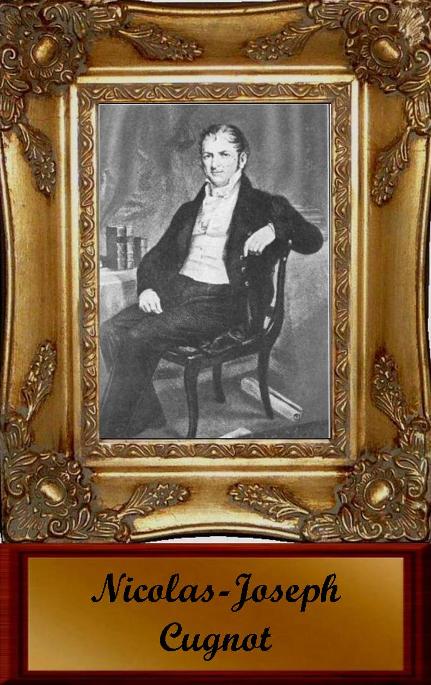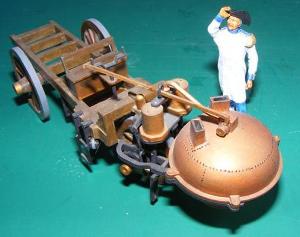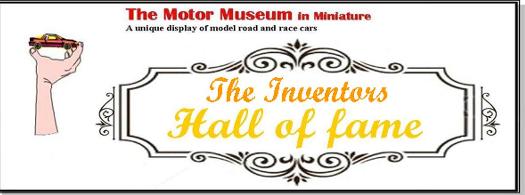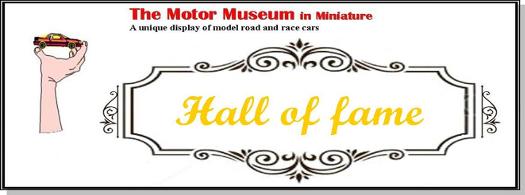
MMIM Hall of Fame
Nicolas-Joseph Cugnot


Nicolas-Joseph (also known as Bob-Joseph), Cugnot was born on the 25th September 1725 in the small town of Void-Vacon, in the department of Meuse, Lorraine, NE France.
He saw military service in the Austrian army between 1743 and 1763 rising to the rank of Captain. His service coincides with the seven years war which affected most of the known world at that time. He is known to have trained as a military engineer which would have provided knowledge and skills he was able to adapt to a variety of tasks later in his life. Cugnot wrote two books about military fortifications and was considered something of expert on fortresses.
After his Military service Cugnot moved to Paris and took up a position as a teacher at the Paris Arsenal. At this time the Arsenal was part of a huge complex of buildings that included one of the best libraries in Europe, the port of the Arsenal and the fortress of the Bastille. This was a place of great power and prestige for the French Court; but also a seat of knowledge and learning for Europe.
Cugnot became interested in steam models there and increasingly involved with experiments. Steam power was becoming more and more useable to the mining industry but as yet no one had succeeded in converting the back and forth passing motion of the cylinder into rotary movement capable of turning a wheel.
The mid 18th. century may have been the ‘age of enlightenment’ for philosophers but it was also a time of great engineers. The political atmosphere of the times meant that, like many industrial innovations, Cugnot’s work would be the product of a military agenda.
Jean-Baptiste Vacquette de Gribeauval had worked very hard to reach the position of ‘ Inspecteur General du Corps Royal de l’artillerie et le Commandant en Chef des Mineurs’. He was widely known for his forward thinking and his organisational skills. He was a staunch advocate of standardization and of the manufacture of field guns to close tolerances. It was important to him that gun parts from the arsenal in southern France could be interchangeable with those of guns manufactured in the northern arsenal. A point later taken up by Henry M. Leland on Cadillac cars 150 years later.
At the same time the French secretary of state for war, Etienne Francois de Stainville, le Duc de Choiseul, was seeking a better method of hauling large artillery without the fuss, needs, or smell, of horses. Self propelled fardiers (a fardier being a huge two wheeled horse-drawn cart for moving very heavy equipment such as cannon barrels) was a very modern idea and very much in keeping with the new spirit of rationalization and standardisation encouraged by General Gribeauval.
In 1865 the Duc de Choiseul instructed Gribeauval and he appointed Nicolas Cugnot to deliver on this Department of Defence funded project.
Cugnot’s first problem was how to successfully employ the reciprocating motion of a steam piston into the rotary motion of a wheel. His answer was to use a ratchet system with the added advantage of being able to go forwards or backwards. He oversaw construction of his machine, which was built at the arsenal by army mechanic ‘Brezin’. On 23rd October 1769, within the grounds of the Paris arsenal, a small three-wheeled fardier à vapeur or, "steam dray", was demonstrated to distinguished government officials. Cugnot’s machine ran for 15 minutes attaining an impressive speed of 2mph. It successfully proved the theories of high pressure steam engines and the conversion of rotary movement from straight to and fro movement.
General de Gribeauval immediately set out specifications for a second prototype. In keeping with military procedures it was expected to follow the army who travel on foot so speed was a consideration. The fardier was to be capable of carrying 4 persons, at least 5 tons and cover 2 lieues (7.8 km or 4.8 miles) in one hour. The vehicle should also be able to traverse rough terrain and climb steep hills. Gribeauval also stated that the second prototype “fardier “ should be designed to have enough autonomy so as to avoid stopping every 15 minutes, which had been a serious drawback of the first prototype.
It is known that De Gribeauval ordered cylinders and pistons from the Arsenal in Strasbourg in April 1770, and had targeted the first trials of the second steam carriage for the November of that year.
As for the actual design of the second fardier it was again a three wheeled vehicle featuring one steerable front wheel, which also provided the driving force, and two larger load wheels toward the rear of the articulated trailer section. The boiler was supported over the front wheel by means of a bracket. This then supplied high pressure steam to two vertical pistons, one on each side of the wheel. These pistons pushed down rods (with the force of around one ton each), set in a pendulum manner, which acted on the ratchet systems, one each side of the axle thereby turning the wheel. We must remember that this reciprocation was transformed into rotary motion before the double-acting Watt machine of 1783, and that the twin-piston steam engine was designed independently of Thomas Newcomen and James Watt. It was rather based directly upon the theoretical work of the French physicist Denis Papin. It was the first engine to employ high-pressure steam expansively, without condensation. Steering was by a quiet advanced rack and pinion system operated by a double handle arrangement. With the steering centred round the point of articulation a lock of about 15-20 degrees was all that was available in either direction. Weight distribution was really very poor and led to great instability, a serious flaw for any vehicle expected to cover rough ground. It was a substantial vehicle and did seat four passengers while moving at a speed of 2.25 miles per hour, a little short of the desired speed.
Between 1769-1770 one Louis Petit de Bachaumont, a French litterateur, published “les memoires secrets”, three memoirs in which he related several things including a report of the performance of “fardier” number two’s speed and load. The steam carriage, which weighed about 2.5 tonnes, had the capacity to run, non-stop, for an hour and 15 minutes; with most contemporary reports saying the machine ran quite well.
Then in 1770 the Falklands Crisis between Britain and Spain saw the end of the Choiseul ministry and on the 26th of January 1771 Louis François, marquis de Monteynard, replaced the Duc de Choiseul as Minister for war. General Gribeauval had lost his political sponsor and although he did write to Marquis de Monteynard, asking him to close the Avenue of Versailles so that tests of the vehicle over uneven ground could be conducted in secrecy, these tests did not take place as the letter was never answered. Instead a demonstration took place before the French public in the streets of Paris with trial runs to Vincennes and Meudon. It wasn’t enough to save the fardier programme.
Although the fardier experiments came to a close the machine was considered important enough to save. It is thought the vehicle ran around the grounds of the Arsenal for a while before it went into storage. There are conflicting reports of a minor incident (in 1771), involving the engine and a brick wall, which resulted in the partial collapse of the wall and the overturning of the machine. Some reports say it was a wall within the Arsenal while others report it being a garden wall somewhere in Paris. The whole affair is somewhat uncertain as the first documented reference for this occurrence comes from 1804 when Georges Ageon wrote the obituary to Cugnot. However, the story persists that this was the first recorded road traffic accident and that Cugnot was arrested and became the first person convicted of dangerous driving.
Despite this setback, and the termination of the automotive adventure, in 1772 King Louis XV granted Cugnot a pension of 600 livres a year for his innovative work. Sadly the Revolution put an end to this pension and in 1789 the inventor was exiled to Brussels where he lived in poverty. Shortly before his death Napoleon Bonaparte invited Cugnot back to France, and he returned to Paris, dying there on the 2nd of October 1804.
Napoleon was not interested in steam so no inventors worked on the subject of steam power in France for the around thirty years. Inadvertently handing Britain a huge advantage as William Murdock, James Watt and Richard Trevithick developed steam engineering immeasurably. But it also meant Naploleon gave the fardier little thought, so it remained safely entombed at the Arsenal. In 1800 it was transferred to the Conservatoire National des Arts et Métiers, where it can still be seen today.
Many people doubted the “fardiers” ability of to run properly. Any examination of the vehicle today confirms it as an experimental machine. In contrast to its mechanical parts, the boiler is a poor design more reminiscent of the boiler of the earlier fardier that could not supply steam for more than 15 minutes at a time. If we accept that the second fardier had an accident, then it is possible that the damaged boiler was replaced by that of the earlier machine in order for tests to continue. For many people the fardier remained a curiosity, very few believing it to be a brilliant piece of historic engineering.
In the current age we can appreciate the best way to test an idea is to replicate it, and a team in Tampa Bay, Florida, did just that. They borrowed a replica from the Deutsche Bahn Museum in Nuremberg and, taking the greatest care to meet all the known technical spec’s, built a working copy of the carriage. They then made an exact copy of the steam engine on the original fardier in Paris in order to power the vehicle. The only concession was to use compressed air in place of actual steam for safety reasons. The team concluded that “the fardier runs very well”. “The engine runs very smoothly and the valve mechanism is very easy to adjust”. “The 1770 rack and pinion steering requires minimal strength to steer”.
It appears that Nicholas Cugnot’s design deserves better recognition; clearly he was no dreamer but an extremely good engineer. Within the context of it’s time (and the knowledge of steam, mechanics and building materials then available), it is an extraordinary machine and a direct ancestor of the motor car.

